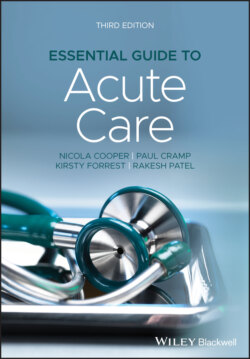Essential Guide to Acute Care

Реклама. ООО «ЛитРес», ИНН: 7719571260.
Оглавление
Nicola Cooper. Essential Guide to Acute Care
Table of Contents
List of Tables
List of Illustrations
Guide
Pages
Essential Guide to Acute Care
Reviews of the Second Edition
Introduction
Note
Acknowledgements
Foreword to the Second Edition
Units Used in This Book
List of Abbreviations
CHAPTER 1 Patients at Risk
What is Resuscitation?
Medical Emergency Teams
Box 1.1 MET Calling Criteria
Do Early Warning Scores and Medical Emergency Teams Make a Difference?
ABCDE – An Overview
Box 1.2 Markers of Severe Illness
Box 1.3 The ABCDE System
Special Considerations in the Geriatric Population
The Benefits and Limitations of Intensive Care
Communication and the Critically Ill
Box 1.4 The SBARR System of Communication
Key Points – Patients at Risk
References
Further Resources
CHAPTER 2 Oxygen Therapy
Myths About Oxygen
Hypoxaemia and Hypoxia
Oxygen Therapy
Nasal Cannulae
Hudson or MC Masks
Reservoir Bag Masks
Venturi Masks
Humidified Oxygen
Flow Versus Concentration
Can Oxygen Therapy Be Harmful?
Hypercapnia and Oxygen Therapy
CO2 Retention
Pulse Oximetry
Oxygen Delivery
Key Points – Oxygen Therapy
Self‐Assessment: Case Histories
Self‐Assessment: Discussion
References
Further Resources
CHAPTER 3 Acid–Base Balance
Acid as a By‐Product of Metabolism
Some Definitions
pH and the Henderson–Hasselbach Equation
Common Causes of Acid–Base Disturbances
Respiratory Acidosis
Respiratory Alkalosis
Metabolic Acidosis
The Anion Gap
Metabolic Acidosis with an Increased Anion Gap
Metabolic Acidosis with a Normal Anion Gap
Mini‐Tutorial: The Use of Intravenous Sodium Bicarbonate in Metabolic Acidosis
Metabolic Alkalosis
Interpreting an Arterial Blood Gas Report
Why Arterial Blood Gas Analysis is Important in Critical Illness
Key Points – Acid–Base Balance
Self‐Assessment: Case Histories
Self‐Assessment: Discussion
Appendix – Checking the Consistency of Arterial Blood Gas Data
References
Further Resources
CHAPTER 4 Respiratory Failure
Basic Pulmonary Physiology
Ventilation
Oxygenation
The Mechanisms of Respiratory Failure
Failure to Ventilate
Failure to Oxygenate
V/Q Mismatch
Intra‐Pulmonary Shunt
Diffusion Problems
Failure to Both Ventilate and Oxygenate
Box 4.1 Preventing Postoperative Respiratory Failure
Respiratory Support
Non‐Invasive Respiratory Support
Non‐Invasive BiPAP
Mini‐Tutorial: NIV for Exacerbations of COPD
Non‐Invasive CPAP
Mini‐Tutorial: High Flow Nasal Oxygen Therapy
Invasive Respiratory Support
Positive End‐Expiratory Pressure (PEEP)
The Effects of Mechanical Ventilation
Mini‐Tutorial: Tracheal Intubation in Acute Severe Asthma
Key Points – Respiratory Failure
Self‐Assessment: Case Histories
Self‐Assessment: Discussion
References
Further Resources
CHAPTER 5 Fluid Balance and Volume Resuscitation
Blood Pressure
Fluid Balance in Health Versus Illness
Sodium and Water Homeostasis in Illness
Prescribing Fluid
Assessing Volume Status
History and Bedside Examination
Lab Tests
Response to Fluid Challenges
Static Measurements
Dynamic Measurements
Different Types of Fluid
Crystalloids
Colloids
Mini‐Tutorial: Controversies over Albumin
Blood
Box 5.1 Complications of Blood Transfusion
Mini‐Tutorial: The Crystalloid Versus Colloid Debate
Key Points: Fluid Balance and Volume Resuscitation
Self‐Assessment: Case Histories
Self‐Assessment: Discussion
References
Further Resources
CHAPTER 6 Sepsis
Definition of Sepsis
Basic Pathophysiology of Sepsis
Immune Response in Sepsis
Metabolic Changes in Sepsis
Tissue Hypoperfusion
Screening Tools for Sepsis
Sepsis Six
Management of Sepsis and Septic Shock
Oxygen Therapy
Serum Lactate Measurements
Blood Cultures
Broad Spectrum Intravenous Antibiotics
Source Control
Intravenous Fluid Administration
Mini‐Tutorial: Fluid Resuscitation in Sepsis
Monitoring, Including Urine Output
Vasopressors and Inotropes
Norepinephrine (noradrenaline)
Vasopressin
Dopamine
Dobutamine
Epinephrine (Adrenaline)
Corticosteroids
The Effects of Sepsis on the Lungs and Kidneys
Other Supportive Care on the Intensive Care Unit
Key Points: Sepsis
Self‐Assessment: Case Histories
Self‐Assessment: Discussion
References
CHAPTER 7 Acute Kidney Injury
Definitions
Basic Renal Physiology
The Pathophysiology of AKI
Renal Hypoperfusion
Sepsis‐Associated AKI
Cardiorenal Syndrome
Mini‐Tutorial: Treatment of AKI in Decompensated Heart Failure
Box 7.1 Common Nephrotoxic Drugs
Nephrotoxic Drugs
Hepatorenal Syndrome
AKI in Major Surgery
Obstruction
Preventing AKI
Assessment of Patients with AKI
Management of AKI
Box 7.2 Treatment of Hyperkalaemia
Mini‐Tutorial: The Use of Intravenous Sodium Bicarbonate in AKI
Renal Replacement Therapy
Prognosis of AKI
Key Points: AKI
Self‐Assessment: Case Histories
Self‐Assessment: Discussion
References
CHAPTER 8 Brain Injury
Cerebral Blood Flow
Intracranial Pressure
Primary and Secondary Brain Injury
Principles of Brain Protection
Managing Intracranial Pressure
Managing Cerebral Ischaemia
Managing Cerebral Oedema
Box 8.1 Methods to Prevent Cerebral Ischaemia
Managing Infection and Other Factors
The Unconscious Patient
Mini‐Tutorial: Subarachnoid Haemorrhage
Box 8.2 The Ottawa SAH Rule
Prognosis Following Cardiac Arrest
Key Points: Brain Injury
Self‐Assessment: Case Histories
Self‐Assessment: Discussion
References
CHAPTER 9 Optimising Patients Before Surgery
The Development of Perioperative Care
Risk Assessment in the Preoperative Patient
Examples of Risk Prediction Tools
Communicating Risk and Informed Consent
The Medical Consultation
The Assessment and Management of Patients with Cardiac Disease
Ischaemic Heart Disease
β‐Blockers in the Perioperative Period
Heart Failure
Valve Disease
Atrial Fibrillation
Hypertension
Patients with Implantable Electronic Cardiac Devices
Mini‐Tutorial: Cardiopulmonary Exercise (CPX) Testing
The Assessment of Patients with Respiratory and Other Diseases
Obesity
Diabetes
Preoperative Assessment of Elderly Patients
Basic Preoperative Optimisation
Mini‐Tutorial: Pre‐Optimisation of High‐Risk Surgical Patients
Key Points: Optimising Patients Before Surgery
Self‐Assessment: Case Histories
Self‐Assessment: Discussion
References
Further Resources
CHAPTER 10 Pain Control and Sedation
Physiology of Acute Pain
An Analgesic Ladder
Paracetamol (Acetaminophen)
Non‐Steroidal Anti‐Inflammatory Drugs (NSAIDs)
Opioids
Morphine
Adjuncts and Regional Anaesthesia
An Antiemetic Ladder
Metoclopramide
Cyclizine and Prochlorperazine
Ondansetron
Haloperidol
Dexamethasone
Lorazepam
Local Anaesthesia
Principles of Safe Sedation
Box 10.1 Guidelines on Safe Sedation
Key Points: Pain Control and Sedation
Self‐Assessment: Case Histories
Self‐Assessment: Discussion
References
Further Resources
Index
a
b
c
d
e
f
g
h
i
k
l
m
n
o
p
q
r
s
t
u
v
w
WILEY END USER LICENSE AGREEMENT
Отрывок из книги
Third Edition
Nicola Cooper MBChB FRCPE FRACP FAcadMEd SFHEA
.....
Airway
Examine for signs of upper airway obstruction
.....